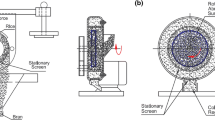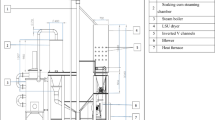Abstract
In this study, instant controlled pressure drop (DIC) treatment was applied for enhancing both process and IR-20 rice quality. This treatment was integrated with soaking and hot air drying (soaking–DIC–hot air drying) in order to improve process performance and quality attributes of the rice. For the optimization, the effect of treatment pressure (TP), treatment time (TT) and decompressed state duration (DD) was investigated on hot air drying time (DT) and head rice yield (HRY). Optimized results were obtained by applying an integrated approach of artificial neural network (ANN) and particle swarm optimization (PSO). With values of TP, TT and DD as the inputs, 3-6-2 was found as the best ANN architecture in order to predict DT and HRY of the DIC-treated parboiled rice. Optimum process conditions as obtained from hybrid ANN–PSO approach were TP of 0.6 MPa, TT of 39 s and DD of 14 s with maximum HRY and minimum DT. The results reveal that IR-20 milled rice produced by DIC-treated parboiling method stands better than conventional method in terms of shorter drying time (DT of 200 min against 1140 min for conventional method), higher degree of gelatinization, higher percent of HRY (70% against 55% of total paddy rice for conventional method), lower broken ratio, ease of cooking and improved pasting and texture properties.




Similar content being viewed by others
Abbreviations
- ANN:
-
Artificial neural network
- ANOVA:
-
Analysis of variance
- ARD:
-
Average relative deviation (%)
- c 1, c 2 :
-
Acceleration constants
- DD:
-
Decompressed state duration (s)
- DF:
-
Degree of freedom
- DIC:
-
Instant controlled pressure drop treatment
- DSC:
-
Differential scanning calorimetry
- DT:
-
Drying time (min)
- H ij :
-
Inputs to hidden layer
- H oj :
-
Outputs of the hidden layer
- HRY:
-
Head rice yield (%)
- L I :
-
Input layer
- L H :
-
Hidden layer
- L o :
-
Output layer
- MSE:
-
Mean square error
- O j :
-
Final output of the output layer
- p g :
-
Position of the best particle
- p i :
-
Best fitness value of the ith particle
- PSO:
-
Particle swarm optimization
- R 2 :
-
Coefficient of determination
- rand ():
-
Random values between 0 and 1
- RSM:
-
Response surface methodology
- RVA:
-
Rapid Visco-Analyzer
- SPSO:
-
Standard particle swarm optimization
- \(T_{\text{h}}\) :
-
Bias values of the hidden layer
- T o :
-
Bias values of the output layer
- TPA:
-
Texture profile analyzer
- TP:
-
Treatment pressure (MPa)
- TT:
-
Treatment time (s)
- v id :
-
dth dimension velocity for the ith particle
- w :
-
Inertia weight for balancing the global and local search ability
- wb:
-
Wet basis (%)
- W ih :
-
Interconnection weights of input and hidden layers
- W ho :
-
Interconnection weights of hidden and output layers
- x id :
-
dth dimension location for the ith particle
- x 1 :
-
TP (MPa)
- x 2 :
-
TT (s)
- x 3 :
-
DD (s)
- β 0 :
-
Constant term
- β i :
-
Linear effects
- β ii :
-
Quadratic effects
- β ij :
-
Interaction effects
- φ 1, φ 2 :
-
Random numbers distribution
References
K.R. Bhattacharya, Parboiling of rice, in ed. by E.T. Champagne. Rice Chemistry and Technology (American Association of Cereal Chemists, Michigan, 2004), pp. 329–404
C.D. Thai, K. Allaf, DIC-assisted parboiling of paddy rice, in ed. by T. Allaf, K. Allaf. Instant Controlled Pressure Drop (DIC) in Food Processing (Springer, New York, 2014), pp. 57–66
S. Soponronnarit, A. Nathakaranakule, A. Jirajindalert, C. Taechapairoj, Parboiling brown rice using super heated steam fluidization technique. J. Food Eng. 75(3), 423–432 (2006)
N. Ali, T.P. Ojha, Cooking quality of raw rice and parboiled rice. Rice Process Eng. Centre Rep. 3(1), 22–25 (1977)
N. Kar, R.K. Jain, P.P. Srivastav, Parboiling of dehusked rice. J. Food Eng. 39(1), 17–22 (1999)
I. Pilatowski, S. Mounir, J. Haddad, D.T. Cong, K. Allaf, The instant controlled pressure drop process as a new post-harvesting treatment of paddy rice: impacts on drying kinetics and end product attributes. Food Bioprocess Technol. 3(6), 901–907 (2010)
P. Khawas, K.K. Dash, A.J. Das, S.C. Deka, Modeling and optimization of the process parameters in vacuum drying of culinary banana (Musa ABB) slices by application of artificial neural network and genetic algorithm. Drying Technol. 34(4), 491–503 (2016)
B. Liu, L. Wang, Y.H. Jin, An effective hybrid PSO-based algorithm for flow shop scheduling with limited buffers. Comput. Oper. Res. 35(9), 2791–2806 (2008)
R. Hassan, B. Cohanim, O. Weck, A comparison of particle swarm optimization and the genetic algorithm, in 1st American Institute of Aeronautics and Astronautics (AIAA) Multidisciplinary Design Optimization Specialist Conference, Austin, TX, USA (2005)
X. Hu, R. Eberhart, Y. Shi, Recent advances in particle swarm, in IEEE Congress on Evolutionary Computation, Portland, OR, USA (2004), pp. 90–97
W.C. Lee, S. Yusof, N.S.A. Hamid, B.S. Baharin, Optimizing conditions for hot water extraction of banana juice using response surface methodology (RSM). J. Food Eng. 75(4), 473–479 (2006)
W.L. Weng, Y.C. Liu, C.W. Lin, Studies on the optimum models of the dairy product Kou Woan Lao using response surface methodology. Asian Australas. J. Anim. Sci. 14(10), 1470–1476 (2001)
S. Kaur, B.C. Sarkar, H.K. Sharma, C. Singh, Optimization of enzymatic hydrolysis pretreatment conditions for enhanced juice recovery from guava fruit using response surface methodology. Food Bioprocess Technol. 2(1), 96–100 (2009)
S. Tripathi, H.N. Mishra, Modeling and optimization of enzymatic degradation of aflatoxin B 1 (AFB 1) in red chili powder using response surface methodology. Food Bioprocess Technol. 4(5), 70–780 (2011)
A. Bhadra, A. Bandyopadhyay, S. Chakraborty, S. Roy, T. Kumar, Development and testing of an ANN model for estimation of runoff from a snow covered catchment. J. Inst. Eng. (India) Ser. A 98(1–2), 29–39 (2017)
S. Chakraborty, M. Sarma, J. Bora, S. Faisal, M.K. Hazarika, Generalization of drying kinetics during thin layer drying of paddy. Agric. Eng. Int. CIGR J. 18(4), 177–189 (2016)
T. Shaikhina, N.A. Khovanova, Handling limited datasets with neural networks in medical applications: a small-data approach. Artif. Int. Med. 75, 51–63 (2017)
R. Eberhart, J. Kennedy, A new optimizer using particle swarm theory, in Micro MACHINE AND HUMAN SCIENCE, 1995. MHS’95. Proceedings of the Sixth International Symposium on IEEE (1995), pp. 39–43
Y. Shi, R.C. Eberhart, Empirical study of particle swarm optimization, in Proceedings of the 1999 Congress on Evolutionary computation, 1999.CEC 99, vol. 3. IEEE (1999), pp. 1945–1950
M. Clerc, J. Kennedy, The particle swarm-explosion, stability, and convergence in a multidimensional complex space. IEEE Trans. Evol. Comput. 6(1), 58–73 (2002)
B. Liu, L. Wang, Y.H. Jin, An effective hybrid PSO-based algorithm for flow shop scheduling with limited buffers. Comput. Oper. Res. 35(9), 2791–2806 (2008)
P. Limpisut, V.K. Jindal, Comparison of rice flour pasting properties using brabender viscoamylograph and rapid visco analyser for evaluating cooked rice texture. Starch-Stär 54(8), 350–357 (2002)
W.E. Marshall, J.L. Wadsworth, L.R. Verma, L. Velupillai, Determining the degree of gelatinization in parboiled rice: comparison of a subjective and objective method. Cereal Chem. 70(2), 26–230 (1993)
P. Sharma, V. Singh, R. Subramanian, Pasting, swelling, and solubility characteristics of rice batter prepared from different wet grinding systems. Starch-Stär 65(5–6), 374–381 (2013)
Author information
Authors and Affiliations
Corresponding author
Additional information
Publisher's Note
Springer Nature remains neutral with regard to jurisdictional claims in published maps and institutional affiliations.
Rights and permissions
About this article
Cite this article
Chakraborty, S., Gautam, S.P., Das, P.P. et al. Instant Controlled Pressure Drop (DIC) Treatment for Improving Process Performance and Milled Rice Quality. J. Inst. Eng. India Ser. A 100, 683–695 (2019). https://doi.org/10.1007/s40030-019-00403-w
Received:
Accepted:
Published:
Issue Date:
DOI: https://doi.org/10.1007/s40030-019-00403-w




